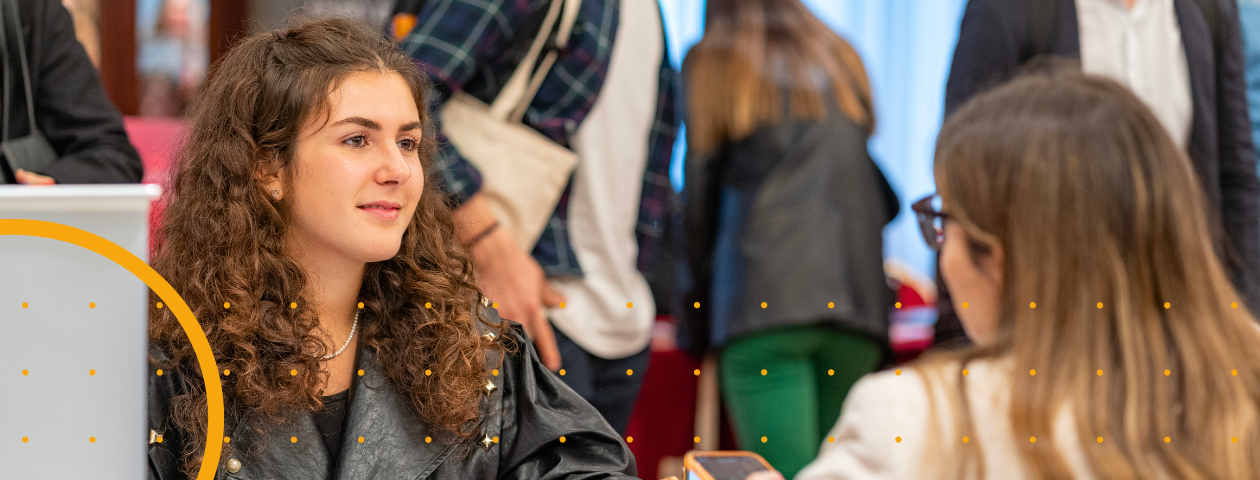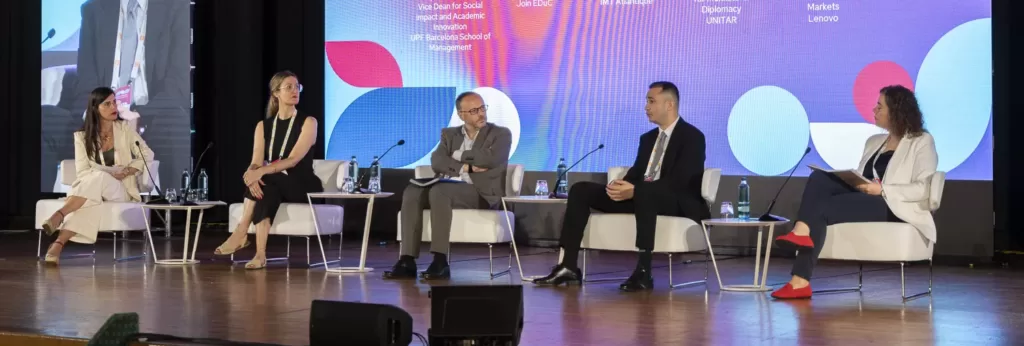
Universities in Europe are striving to embed sustainability principles into their operations, curriculum, and research. The insightful discussions at the QS Higher Ed Summit: Europe 2024 highlight the region’s ongoing challenge of effectively measuring and evaluating progress in sustainable practices.
In a panel discussion titled ‘Measuring Sustainability’, experts examined the existing frameworks institutions and organisations use to gauge sustainability efforts. The discussion also addressed the challenges and emerging solutions in this area, emphasising the growing need to leverage technology to enhance sustainability efforts in alignment with the Sustainable Development Goals (SDGs).

A focus on education, climate action, and global partnerships
Mazin Khan, Consultant in the Division for Multilateral Diplomacy at United Nations Institute for Training and Research (UNITAR), kicked off the panel by sharing one of UNITAR’s alignment strategies ‘Curriculum Amendment’, and their prioritised SDGs at the organisation: SDG-4 (Quality in Education), SDG-13 (Climate Action), and SDG-17 (Partnership for the Goals).
“At UNITAR, we believe that we need to incorporate SDGs within the university curriculums and target relevant courses. A great example of this is our programme called ‘Digital International Relations and Diplomacy’.”
He also highlighted the value of an interdisciplinary approach to address economic, social, and environmental issues. Leveraging their extensive UN network, UNITAR collaborates with various UN agencies and institutions to create rigorous yet practical academic content.
“We all like to assume that sustainability education is creating an impact, but we don’t actually have a lot of evidence of that yet.”
Carrina Hopper, Co-founder at Join EDuC
Grading the curriculum
Universities hold a significant responsibility for environmental stewardship – it extends beyond teaching sustainability, and in to how they make their operations more sustainable. QS Stars is an in-depth framework to rate and compare university performance; one category institutions can be passed on is Environmental impact, where we look at an institution’s sustainability research, plans and monitoring systems.
Additionally, the QS World University Rankings methodology incorporates sustainability; universities can gauge their commitment to sustainability and track their progress.
Carrina Hopper, co-founder of Join EDuC, developed the ‘Starter Test’ as a way to measure the maturity level of any higher education programme. She encouraged universities to leverage this tool monitoring their progress in sustainable practices.
“It’s a free 23 question maturity assessment for universities to get instant results on how their programme is doing, by offering the senior management access to a full university report on all of the different programmes at the institution.”
For 58% of prospective Western European students looking to study abroad, a university working with local communities on sustainable and social justice initiatives is among their most important factors when judging whether a university is environmentally sustainable.
QS International Student Survey 2024
Making change at the strategic level
In the same panel, Christophe Lerouge, President at IMT Atlantique discussed the institution’s newest strategy to measure how they’re achieving sustainability, which took a year to define and align with SDGs.
In the strategy, IMT Atlantique prioritised sustainability, diversity and social impact. “Through this strategy, we defined a KPI in training, research and how the university works,” Lerouge said.
“In terms of measurement, we count the number of publications in research publications linked to the SDGs. We obliged our teachers to transform their courses because we want all of our students to be trained taking into account sustainability, and the knowledge of scarcity of resources, energy, the environment and the social impact.
“Also, in France we have a reference system that is delivered to French universities, and every four years, we have to go through the system to provide proof that we’re moving forward and taking sustainability into account. It enables us as institutions to define targets, take action and prepare for the future.”
38% of students actively seek information about how higher education institutions utilise AI and technology when researching universities.
QS International Student Survey 2024
How is technology being used to enhance sustainability and reduce carbon emissions and how important is it?
Ensuring sustainability is not just about teaching, it’s also about the operational level – at UNITAR, they’ve used the Metaverse to reduce their carbon footprint:
“I think leveraging our online platform and our e-learning elements including a programme called ‘The UN Young Leaders’ and ‘Diplomacy 2.0’ have been very important. It allows us to access markets we normally couldn’t reach and significantly reduce carbon emissions.”
The importance of public-private partnerships
According to Mazin, private sector partners have enabled UNITAR to access new resources and geographic locations, significantly enhancing their sustainability efforts.
“Universities often look at sustainability as an extra cost. But in fact, adding in these sustainable elements and a level of technology really gives your programme a USP. It’s greener, and I think the modern student really looks at these aspects, not just your day-to-day curriculum.”
In a previous QS article with Delft University of Technology, recognised as the most sustainable university in continental Europe, Professor Andy van den Dobbelsteen, Sustainability Lead and Professor of Climate Design & Sustainability, emphasised that while sustainable interventions may be perceived as costly, they are actually long-term investments with significant benefits.
“AI is a fascinating tool that we can’t escape from, so let’s make sure that we’re using it for the right purpose.”
Virgine Le Barbu, Global Sustainability Director at Lenovo
Which frameworks or metrics are being used to measure sustainability at an innovative technology company?
Virgine Le Barbu, Global Sustainability Director at Lenovo, explained how they ensure their operations are sustainable:
- Accessible computing: To ensure they are facilitating virtual and physical collaboration regardless of a user’s location.
- Facilitating access to data: This also includes the usage of data, to make sure that people can make smarter and quicker decisions.
- Moving from product-centric to service led: To make sure Lenovo is driving the right behaviour particularly around circular economy and carbon reduction.
- The integration of innovative and responsive solutions: To enhance skills development and learning within Lenovo.
“We have also just announced the nomination of our Chief Security and AI Officer, we will be championing AI policing internally and also working with our responsible AI Committee. This is to make sure that any solution developed around AI will answer different pillars, including diversity, inclusion social and environmental impact, transparency, accountability and security. AI is a fascinating tool that we can’t escape from, so let’s make sure that we’re using it for the right purpose.”
How can universities and industries collaborate to advance sustainability in teaching and research?
“There is a transformation happening in the corporate world where we lack skills, knowledge and expertise access.” Le Barbu answered.
While universities supply talent, Le Barbu emphasised that corporations can offer a collaborative environment for co-creation. With increasing regulations, the corporate industry faces pressure but struggles to find the right talent. At Lenovo, for instance, they are collaborating with external educators to develop universal models that can be shared across their eco-system, fostering a common language. Additionally, they’ve integrated curricula with real-world problem-solving and hands-on learning to better prepare future workers.
Key takeaways of best practice
1. Integrate sustainability into curriculum and operations: Using tools like the QS Stars and the ‘Starter Test’ to measure the maturity and effectiveness of an institution’s sustainability efforts – tracking progress more accurately.
2. Leverage technology: Utilising advanced technology, such as the Metaverse for online learning and AI for responsible decision-making, can significantly reduce carbon emissions and improve sustainability outcomes in both education and operations.
3. Foster public-private partnerships: This can provide universities with additional resources and opportunities to enhance their sustainability initiatives, making these efforts more impactful and widespread.



